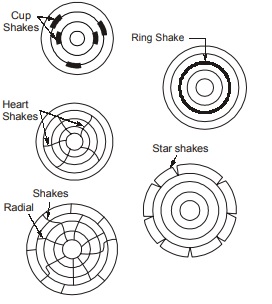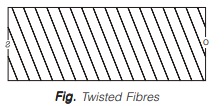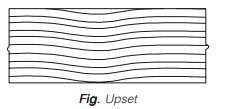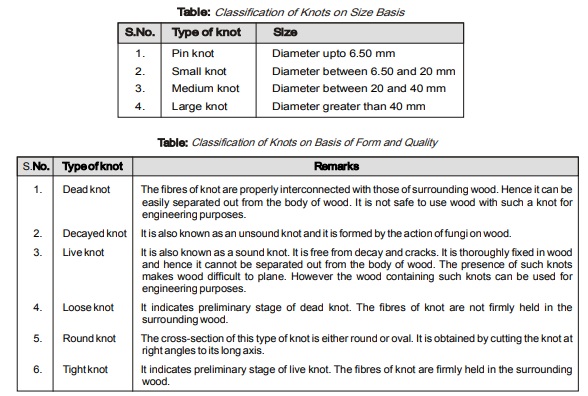Type of Shakes
Shakes and Type of Shakes
(a) Cup Shakes:
These are caused by the rupture of tissue in a circular direction. It is a curved crack and it separates partly one annual ring from the other. It develops due to non-uniform growth. It may not prove to be harmful, if it covers only a portion of ring.
(b) Heart Shakes:
These cracks occur in the centre of cross section of tree and they extend from pith to sap wood in the direction of medullary rays. These cracks occur due to shrinkage of interior part of tree which is approaching maturity. Heart shakes divide the tree cross-section into two to four parts.
(c) Ring Shakes:
When cup shakes cover the entire ring, they are known as ring shakes.
(d) Star Shakes:
These are cracks which extend from bark towards the sap wood. They are usually confined up to the plane of sap wood. They are usually formed due to extreme heat or frost.
(e) Radial Shakes:
These are similar to star shakes. But they are fine, irregular and numerous. They usually occur when tree is exposed to sun for seasoning after being felled down.

Some of the defects due to natural forces are:
(i) Burls
(ii) Callus
(iii) Chemical stain
(iv) Coarse grain
(v) Dead wood
(vi) Druxiness
(vii) Foxiness
(viii) Knots
(ix) Rind galls
(x) Shakes
(xi) Twisted fibres
(xii) Upsets
(xiii)Water stain
(xiv) Wind cracks
(i) Burls:
They are particularly formed when a tree has received shock or injury in its young age.
(ii) Shakes:
These are cracks which partly or completely separate the fibres of wood. Following are the different varieties of shakes:
(iii) Twisted Fibres:
These are also known as wandering hearts and they are caused by twisting of young trees by fast blowing wind. Timber with twisted fibres is unsuitable for sawing.
(iv) Upsets:
These are also known as ruptures and they indicate wood fibres which are injured by crushing or compression. Upsets are mainly due to improper felling of tree and exposure of tree in its young age to fast blowing wind.

(v) Knots:
- These are base of branches or limbs which are broken or cut off from the tree. The portion from which the branch is removed receives nourishment from the stem for a pretty long time and it ultimately results in the formation of dark hard rings which are known as the knots.

- These are caused by wood limb encased by wood of tree trunk.
- Caused when branch base embedded in timber by natural growth.

(vi) Rind Galls:
The rind means bark and gall indicates abnormal growth.
- Peculiar curved swellings found on the body of a tree are known as the rind galls.
- They develop at points from where branches are improperly cut off or removed.
- They are rarely found in a tree and the timber in this part is very weak and not durable.
Defects due to Seasoning
Following defects occur in seasoning process of wood:
(i) Bow
(ii) Case-hardening
(iii) Check
(iv) Collapse
(v) Cup
(vi) Honey-combing
(vii) Radial shakes
(viii) Split
(ix) Twist
(x) Warp
(i) Bow :
This defect is indicated by the curvature formed in the direction of length of timber.
(ii) Cup:
This defect is indicated by the curvature formed in the transverse direction of timber. Unequal shrinkage in radial and tangential direction is cause of cup.
(iii) Case Hardening:
The exposed surface of timber dries very rapidly. It therefore shrinks and is under compression. The interior surface which has not completely dried is under tension. This defect is known as the case – hardening and it usually occurs in timbers which are placed at the bottom during seasoning.
(iv) Check:
A check is a crack which separates fibres of wood. It does not extend from one end to the other.
(v) Collapse:
Due to uneven shrinkage, the wood sometimes flattens during drying. This is known as the collapse.
(vi) Honey combing:
Due to stresses developed during drying, the various radial and circular cracks develop in the interior portion of timber. The timber thus assumes the honey-comb texture and the defect so developed is known as the honey-combing.
(vii) Radial shakes:
These are radial cracks.
(viii)Split:
When a check extends from one end to the other, it is known as a split.
(ix) Twist:
When a piece of timber has spirally distorted along its length, it is known as a twist.
(x) Warp:
When a piece of timber has twisted out of shape, it is said to have warped.
<< Previous | Next >>
Must Read: What is Construction Material?

